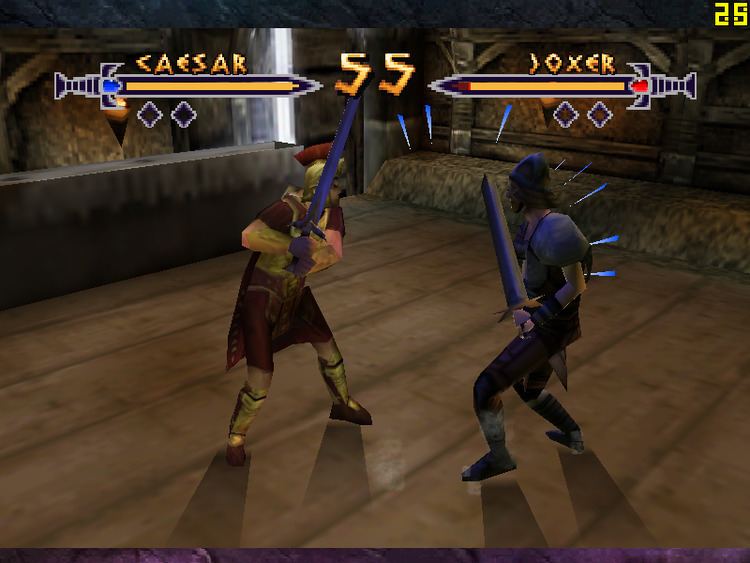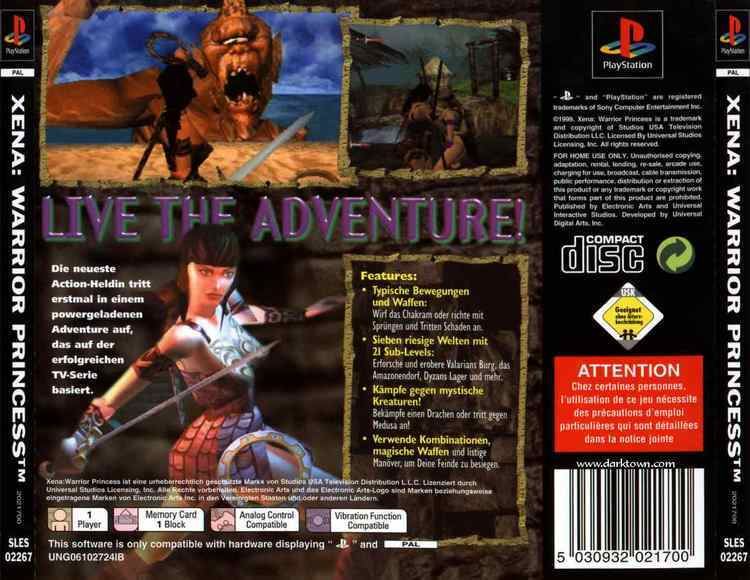Mode(s) Single player Genre Hack and slash | Initial release date 1999 | |
 | ||
Artist(s) Mark Franklin (PlayStation) Engine RenderWare (PlayStation 2) Platforms PlayStation, PlayStation 2, Game Boy Developers Titus Interactive SA, Blast! Entertainment, Vivendi, Universal Interactive, Universal Digital Arts, Inc. Similar Titus Interactive SA games, Beat 'em up games | ||
Xena: Warrior Princess is a hack and slash action video game developed by VU Games and published by Electronic Arts for the PlayStation in 1999. A Game Boy Color version was developed and published by Titus Software in 2001. A PlayStation 2 version, developed by EM Studios and published by Blast! Entertainment, was released exclusively in PAL territories in 2006. Each version is based on the television series, Xena: Warrior Princess, which aired from 1995 to 2001.
Contents
- PlayStation version
- Game Boy Color version
- PlayStation 2 version
- Development and release
- Reception
- References

PlayStation version

The PlayStation version of Xena: Warrior Princess is played from a third-person perspective and consists of linear hack and slash and action gameplay, with some platform-jumping and puzzle-solving sections. The game's story involves the evil sorceress Kalabrax, who escapes after centuries of imprisonment and plots revenge against the world, and against the gods who imprisoned her. She must sacrifice a queen for her spell to gain maximum power. With help from her allies, Kalabrax captures Gabrielle, the Queen of the Amazons. Xena, the warrior princess, embarks on a journey to rescue Gabrielle, while facing various villains along the way.

The player controls Xena, who must defeat all enemies and complete tasks to proceed through each level of the game. Xena can carry out numerous attacks through a combination of button commands performed by the player. If the attack is executed successfully, Xena lets out her signature warrior scream. Xena can run, jump, kick, slash, and block enemy attacks, as well as perform groin kicks and cartwheels.

The player can also use power-ups found throughout the game. Power-ups can replenish the player's health, as well as provide armor upgrades or additional attack abilities. The player can also use Xena's chakram, a weapon featured on the television series. The chakram can be used against enemies, as well as cutting chains and flipping switches. Optionally, the player can also steer the chakram while it is in mid-air, for a better chance of hitting a target. Xena can also use a sword. Both weapons can be upgraded by collecting power-ups. The player can only attack one enemy at a time, and is defenseless against nearby enemies while the chakram is in use.
The game features 21 levels. Early levels, and some of the later levels, include tasks in which Xena must rescue hostages by using a long-distance attack against the enemies. If the player merely beats up an enemy rather than kill it, karma is added to Xena's karma meter. When the karma meter becomes full, the player receives temporary invincibility. Defeating boss enemies typically requires the player to perform certain actions, as Xena's weapons do not have any effect on some of them. Scrolls found on various levels provide the player with hints, such as information on how to defeat boss enemies.
Game Boy Color version
The Game Boy Color version is a side-scrolling platform action game played primarily from an overhead perspective. The game's story focuses on Xena, who is stuck in a dream world known as Psychosia and must locate Darphus, who is responsible for trapping her there. Xena must also locate Morpheus, who is the only one with the power to send her back to reality.
The player controls Xena, who can run, jump, climb, and swim. Xena can also use items such as maple syrup and keys. A total of 13 items can be found throughout the game, and are stored in an inventory screen. The player can equip up to two items. Xena's health is represented by hearts. Health can be increased by finding heart containers throughout the game. The game features 16 levels. The game can be linked up with Hercules: The Legendary Journeys, allowing the player to play as Hercules, who is capable of accessing secret levels.
PlayStation 2 version
The PlayStation 2 version is an action platform/adventure video game played from a third-person perspective. The game's story involves Ares, the God of War, who has captured Gabrielle and chained her in a dungeon that is quickly filling with water. Xena must work her way through Ares' castle to rescue Gabrielle before time runs out. Playing as Xena, the player must overcome enemies, traps, and puzzles. The game features nine levels, as well as Xena's chakram weapon.
Development and release
Universal Interactive Studios developed the PlayStation version. Universal created several new characters specifically for the game, including Kalabrax and the Amazon Bird Women. Universal also created over 100 different animations for the character of Xena to ensure smooth movements in the game. In addition, the faces of the television show's actresses, Lucy Lawless (Xena) and Renee O'Connor (Gabrielle), were texture-mapped into the game. The PlayStation version was published by Electronic Arts on October 7, 1999, following the premiere of the television show's fifth season.
In November 1998, Titus Software announced that it had acquired the rights to produce video games based on the television show. In May 2000, Titus announced that a Game Boy Color version of Xena: Warrior Princess was scheduled for release at the end of summer 2000. The Game Boy Color version, developed and published by Titus, was ultimately released on July 30, 2001.
EM Studios, of the United Kingdom, developed the PlayStation 2 version using the RenderWare game engine. The game was published by Blast! Entertainment on December 5, 2006, exclusively in Europe.
Reception
The PlayStation version of Xena: Warrior Princess holds a 66 percent rating on GameRankings, based on 11 reviews. Official U.S. PlayStation Magazine rated the PlayStation version 3.5 out of 5, while Nintendo Power rated the Game Boy Color version a 3 out of 5.
Joe Fielder of GameSpot gave the PlayStation version a rating of 4.6 out of 10, and criticized the fact that Xena is defenseless while using her chakram weapon. Fielder also noted that the game's characters "all look very blocky, and the backgrounds are basic and sparse." Fielder said the game's platform-jumping and puzzle-solving sections were not fun because of the game's poor camera system: "The camera has a mind of its own at times, swinging this way and that in some situations while taking too long to catch up to your character in others. On top of that, the controls that let you adjust the camera manually feel backward and the perspective shifts too slowly to be much use in tough situations. [...] You'll fly easily through this title if you can find the motivation to attempt it, the hardest tasks being those set by working with the camera." Fielder ultimately concluded that the game "feels as though its developers were focused so intently on making the title carry mass appeal that in the end, the result is a watered-down, thin, sorry state of a game barely deserving of a rental, let alone a purchase. Like Xena? Stick to the TV show and put this one out to pasture."
Dean Austin of IGN rated the PlayStation version a 6.5 out of 10 and noted its outdated graphics, but praised its design and the pacing of its music, as well as the chakram, calling it "by far the most innovative part of the game." Austin also wrote, "The levels are involved but not particularly deep and the overall time of play is an issue. Only Xena could have so much skin exposed running around in snow covered mountain levels. [...] It's a shame that Gabrielle was not used more as a base character. A game that featured two-player co-operative play controlling both Xena and Gabrielle would have been most welcome." Austin also complained of "warping and camera clipping problems that occur throughout the game. These two problems impact gameplay at inopportune times (not to mention the excessive pop-up)."
Jason White of AllGame gave the PlayStation version 3 stars out of 5 and wrote, "The characters and bosses are average as far as appearance goes and the game itself isn't very inventive. Hardcore gamers will find this okay to rent but most diehard Xena fans will love this game." White noted that the "gameplay is extremely basic. While you can wander anywhere on the screen, the game itself is a strict linear adventure. If you don't beat all the enemies nor complete whatever task is asked of you, then you can't move on. Xena walks along a paved path throughout the adventure, sort of 'yellow brick road-ish.' You walk down the path, fight the bad guys, get a key and go through a gate. This is pretty much how the game plays the whole time. There are painfully long load times between levels. A bit of slow down occurs when Xena fights too many enemies at once which lets one or two of them get in a free shot while you're left trying to face them." White also wrote, "There are only two real down sides to the game. There are so many moves to use that you need a few extra fingers to press all the buttons so you can see all her moves. [...] The other is that in order to perform simple tasks like jumping, you need to use a certain button combination, otherwise you'll end up going past or coming up just short of your mark. The one thing missing is that you can only attack one enemy at a time, very un-Xena like."
Jules Grant of The Electric Playground gave the game a 7 out of 10 and wrote that it "accurately recreates the atmosphere of the television series and uses some of the same characters. [...] This game is always fast and furious and the environments, particularly the outdoor areas are unmatched on the PlayStation." Grant criticized the game's camera system, writing, "Camera work is always a sticky item in 3rd person perspective games. In Xena, because of the speed of the melee combat and the 360 degree action, the camera gets to be a real problem." However, Grant wrote that the camera issues were not "overly irritating". Grant noted the "very short and focussed levels", as well as the difficulty of the final boss battle, which was largely due to camera issues.
